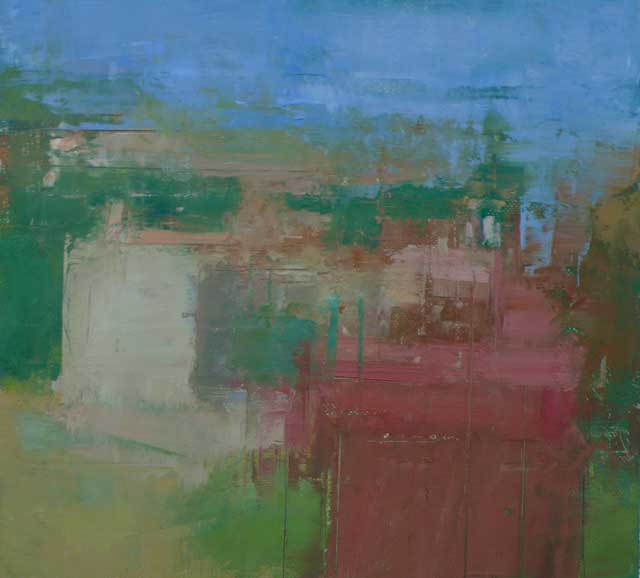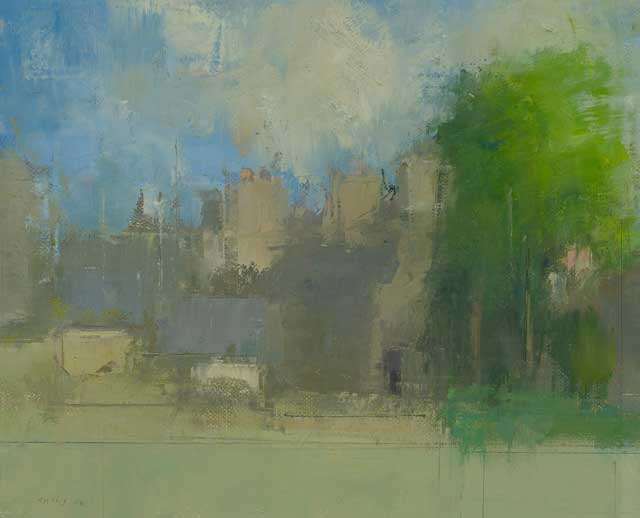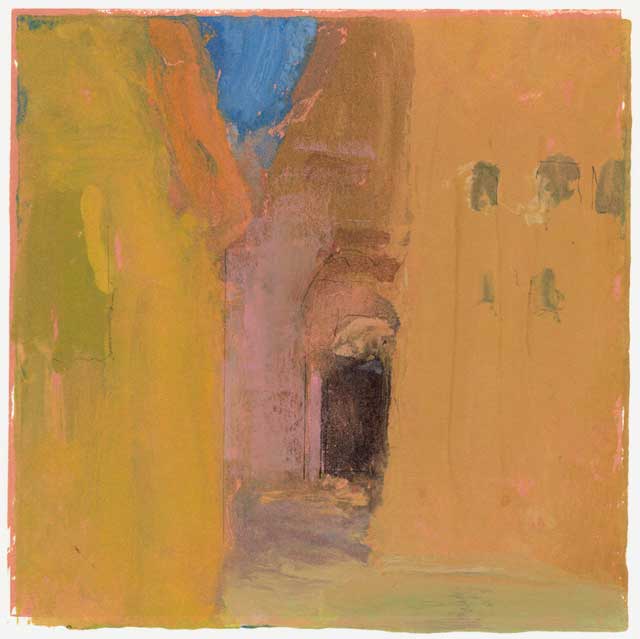LG Many painters today working from observation, especially the popular “plein air” painters, are drawn to paint picturesque scenes in an impressionistic or naturalistic style. Your work differs sharply in that there is an attraction to views that inspire more abstract painting ideas rather than sentimental notions of a beautiful landscape. Can you say something about the importance of avoiding Kitsch or sentimentality in landscape painting.
SS I really know very little about the world of “plein air” painting as it is practiced in America now, so I should probably keep my mouth closed on this issue. Where I was educated there was no exposure to that school of thought, and I suppose that the people I have been hanging out with all these years live in a different world. But in my travels I have seen some evidence of what goes on. Look, there are many ways of making paintings and we all make choices along the way. One thing I have found in the plein air movement is that a lot of people teach technique in the service of making a predetermined finished product maybe without much room for driving off the road into unexpected discovery because there are established models of what is right, and that is what most practitioners are striving for. And that is ok because it is like that with many things, but in a way I’d like to see more curiosity that breaks out of the predictable.
Kitsch is a seductive and complex issue and America seems adrift in kitsch and the thing is that unless one has access to the kind of renewal that comes with looking at very fine work in museums or galleries, kitsch becomes normalized. And it has nothing to do with economics or class, kitsch and mannerisms of all sorts are pervasive in every stratum from high to low. And kitsch is closely related to subject matter and attitude, but also to the use of paint itself. Like, there is certain kind of sleazy painting done with the palette knife that before we even have any idea what it is we are looking at, our stomachs are turned by revulsion to the kitschy use of the knife. Ok, this is very difficult ground to walk on and I don’t want to insult anyone or to say this kind of painting is better than that kind. But from coast to coast, Kitsch abounds, in academies, ateliers, tourist galleries, and in even not tourist galleries – it’s like a disease that spreads while we sleep and I don’t know what we can do about it other than gird our loins, wash our hands or use protection.
LG There is a common visceral attraction to paintings that successfully captures a sense of place and light, like the light in Corot’s Italian plein air landscapes. Lessor painters might paint light, forms and space just as convincingly but their work is weak and uninteresting when compared to a master like Corot. What pushes painting out of being merely competent and into the realm of exceptional?
SS This issue of what makes a painting just ok as opposed to what make another exceptional is not a matter of mechanical technique, but it has to do first, with the ability of the painter to feel deeply and as Joan Mitchell said, to have “access” to herself or himself – to have access to feeling and deep response and then to know how to put that into concrete form. And like comparing Mozart to Solieri, there is no comparison. Solieri wasn’t bad but Mozart was more than good. Similarly, a lot of guys are fantastic guitarists and work in recording studios on albums for other people who may be more well known, and these guitarists have supreme technique, maybe even better than the musicians whose albums they are recording. But they will never have that sort of unique independent career because at the end of the day, while they are supremely talented mechanics they are not really inventive poets. And there are of course good paintings and bad paintings, and some of the bad ones are not so bad in terms of technique, but they are not inspired and without that, there is only so much time in the day. Just go and visit many of the contemporary ateliers rooted in fundamentalist interpretations of the past, the are very earnest in the evidence of labor, focus and determination, and there is good “technique”, but they are terribly boring. Also, let’s not forget that both Hitler and Mussolini liked a kind of art not too far removed from what is taught at many of these ateliers which is a mostly, as was then, profoundly disappointing kitschy, serious misinterpretations of classicism. We should try to remember that the message from the old masters is NOT to do as they do. None of them want us to paint pictures that look like theirs – they are offering much deeper messages and currents of meaning and visual thought for us to absorb and to consider, it is not about superficial style.
LGThere has been wide interest in your outdoor painting intensive workshops, including advanced painters far along in their careers. I’ve heard from a number of painters that your workshop significantly helped to jump-start and re-think their painting process, as I can attest from my own experience with your teaching this past summer. You don’t teach formula, method, or technique but instead teach far more valuable ideas like the importance of visual clarity and unity. Please tell us some of what you offer with your intensive “The Structure of the Visual Moment” workshops.
SS If anything, my class is designed to promote several levels of visual and conceptual clarity and not with making any sort of product, nor with any sense of preconceived “finish” or polish. I’m not interested in results that relate to putting in all the details, learning how to finish, pretty picture making or something to take home to impress the grandmother (so to speak). And the last thing in the world I want is to teach anyone to paint like me, God forbid. Ironically, the thing is that I don’t even know how I paint. Or if I do I’m trying to forget that and relearn something else.
In these classes I try to address issues of perceptual organization and then the process of invention on the two dimensional work surface. Translating what we make of what we saw into something graphic is at the heart of the matter, and of course to being supremely conscious of and responsible for all the moves from beginning to end. If someone wants to learn “how to” make a certain kind of picture, or a “landscape painting”, please know in advance, this is not the place for that. By way of holding the brush while looking out into visual space, we are more interested in addressing qualities of perception and recognizing the large, looming issues behind what we are doing and what we are after. First we are making a “painting” before it is a “landscape.”
If I “taught” or emphasized technique or method I might be offering a quick/superficial fix that in the long run would be deceptive and not work. It might feel like a short term satisfying solution but it wouldn’t offer anyone the analytical musculature needed for carrying on in their own lives expect for copying what someone else does. Working in front of nature is full of immense opportunity but I really don’t expect anyone to necessary go home with anything fully resolved, it’s too much information being presented and it all takes time to digest. I always tell people, what they will have is a seed in a peat pot surrounded by soil and they need to take it home and make sure it’s watered and kept in the sun.
Remember what Corot said, “When one follows another, one is always behind.”
LG Thank you again Stuart for taking the time to share this with our readers. If anyone is interested in taking a workshop with Stuart Shils you can contact him directly through his website (in the teaching section). If you live on the West Coast or wish to travel to San Diego next Spring or early summer you can leave a comment here or send me an email.








Very inspiring and wise !
Outstanding! Thanks so much for this interview. He’s one of my favorites and I would love to take his class. He talks about a lot of the things I’m struggling with right now. Maybe Santa will reward me for being good all year.
Some great intense thoughts on painting and seeing. I really like the ideas he was talking about regarding the difference between ‘landscape’ and ‘scenery’, and how painters need to edit out the observed, see-able world, and focus on the construction of what’s happening on the picture plane. His work speaks of a deep involvement with the world, and it shows. Thanks
Great interview Stuart and Larry. Many thanks and will pass this on to the students etc… Best, IH
Thank-you very much Stuart and Larry… nice interview.
It is thrilling to read this discussion which has much to consider and digest.
Yeah, this was a really good interview. Painting as connected to a Kinks chord or whatever it is that grabs us in the world of our senses is really the game and Stuart has a great way of conveying the excitement of it with words and, of course, with his art.
thanks to both you.
dm
Awesome interview, Larry! I ended up doing his workshop in Philly and had a great experience. He is an incredible artist and instructor, as well as a great person. A lot of what was touched on in the interview was discussed in the class as well. Nice to have this wonderful resource to read over and really digest. My seed is taking root!
Hi Larry,
This is one of those interviews that I want to read every day. So many truths and poetic ways of describing the way we think and see as artists. LOVED IT!!
Thanks tons, love your blog!
Happy Holidays to YOU
Terrific interview! Questions and answers all so thoughtful, original, articulate, and helpful. I’d like to take a class in California in spring or early summer.
Absolutely outstanding!
This should be required reading for every art student and I would go s far as saying that every working artist would benefit from reading this often. So full of experience and intelligence! The paintings and drawings are truly beautiful as well.
Thanks for taking the time with this Larry and Stuart.
Thanks very much for doing this interview. Shils has always been one of my favorite painters, and this was wonderful to read and see. I particularly appreciate seeing his sketches, which are amazing.
Great interview on an inspiring artist! Much appreciated.
I got a chance to have Bill Scott in my studio during grad school and was really inspired by his perspective on observational painting. It makes it even more exciting knowing that a painter that I respect as much as Stuart holds Bill in such high regards as well. Great interview! Thanks, Dustin O’Hara
Love your stuff man. Very unique love the abstract qualities and the brightness of the colors. Really rate-type look. Ultra cool.
Great interview on an inspiring artist. Great collections of paintings there.